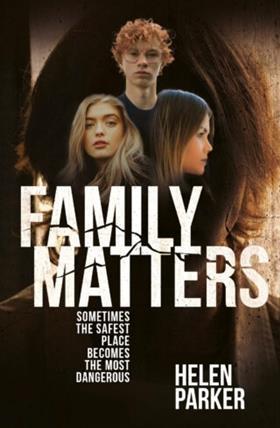Helen Parker explores how Christian parents can help their youth and children explore the Christian faith through fiction

Long ago, before my husband and I had children, we were staying with a family who had teenagers. Together we watched a TV series featuring an alcoholic. I was surprised that the parents allowed their young people to watch it, but the ensuing discussion proved invaluable.
“Mum, do people really do that when they’re drunk? Can alcohol affect people as much as that? What happens to them in rehab? Is there a cure?”
The conversation continued. It was easy to see the wisdom of learning certain truths—albeit unpalatable ones—through fiction, in the safe environment of home.
Most of us enjoy fiction: films, TV, Netflix, box sets, short stories, and novels. We think ourselves into the characters we admire. We become the superhero, the feisty, intuitive scientist, the successful business tycoon/lawyer/detective. Identification with the protagonists engenders the whole range of emotions, and it’s so much the better if our heroes are flawed people like us. My husband watches TV fiction silently, drinking in characters and plot, but I find myself verbalising my hopes and fears: “Why doesn’t he…? She should… Oh no, they’re going to…,” because I’m so invested in the outcome.
And what about stories and novels? Whether it’s David Copperfield or Demon Copperhead, we need a hero we’ll be rooting for because we believe in him or her. Despite their imperfect characters and many mistakes along the way, we become bound up in our protagonists’ misfortunes, successes, and challenges. An essential prerequisite in any story is a central character we’re rooting for. The significance of this is that, in engaging with characters within fiction, we formulate understanding, ideas, and aims.
Examples of stories that teach
Many writers of novels for children and young people aim to do more than merely spin a good yarn. The Story of Tracy Beaker is the novel that put Jacqueline Wilson on the map as a children’s author. Tracy is a feisty child who lives in an orphanage but who longs to be adopted. The novel chronicles her emotional struggles, her identity, and her relationships. It was her rebelliousness and imperfections that made her likeable. In the early 1990s, it was a significant departure from traditional children’s literature. Wilson went on to champion children from all backgrounds and in all situations—rich or poor, clever or less clever, quiet or rambunctious.
Read more
Anne Fine has written over fifty books for children and young people. She has claimed she wanted any child to be able to find his or her place in her books. “A lot of my work, even for fairly young readers, raises quite serious social issues,” she admits. “Growing up is a long and confusing business. I try to show that the battle through the chaos is worthwhile and can, at times, be seen as very funny.”
A Monster Calls, Patrick Ness’s teen novel about mature themes such as cancer, bereavement, bullying, and loneliness, is a fantasy story that aims to reassure and strengthen. It offers lots of empathy and wisdom.
Faith in fiction
When you’re young, the world is your oyster. You can become anything you want—at least in your imagination. Like your fictitious hero, you can dream, grow, be clever, wise, helpful, confident, and loyal. Cue writers to offer heroes with positive traits—heroes who, aware of the dangers and pitfalls of daily living, overcome difficulties with faith and bravery. The pivotal word here is faith.
The best fiction is true in the very deepest sense of the word, and parents can use it to foster the faith of their youth and children.
Among the young people’s books I’ve read with faith‑based themes, I’ve found lots of beautifully retold Bible stories for younger children and a number of allegorical fantasy or superhero books for older children and young people. C. S. Lewis’s Narnia stories are an obvious example. But I haven’t found many stories about “normal” young people in realistic situations. If all of us—young or less young—can be influenced in our thinking by the protagonists we admire, then surely there is huge scope for writers to craft heroes of faith, even wavering or nascent faith, who approach life’s ups and downs in a way that strengthens their trust in God.
Life is never monochrome. Many multidimensional challenges are particular to young people: friendships and family relationships, social interaction, identity, body image, school subject choices, and career aims. Add to those specific problems such as bullying, change, financial deprivation, loss, uncertainty, or danger—and you have the makings of real life and a need for direction and help. How can young people pray about those issues? What does the Bible have to say?
A new opportunity
In the mid‑twentieth century, Patricia St John’s children’s novels were much loved for their realistic heroes and believable situations. They still are. But life for youngsters seventy or so years later has changed incalculably, and millions more books have been published.
I have aimed for a positive contribution in my series of three novels about Ruth and Christopher. In Hide and Secret, twelve‑year‑old Ruth copes with a major life change while trying to “live in the light” and keep secrets without telling lies.
In Island Treasure, Christopher’s family moves to a remote Scottish island—Sunnaig. Among his new friends are two child refugees, but when they fall foul of a bullying youth, life‑changing events unfold. How should he react in the face of meanness and racist comments? Where does forgiveness come in?

Readers of Family Matters will meet Ruth and Chris again. Now they are a little older and come up against domestic abuse. What happens when friendship and loyalty seem misplaced? When a crisis rears its ugly head, is it time to speak out?
Fiction can help young people foster supportive friendships, encourage honesty, inspire bravery, and boost confidence. It can also inculcate biblical truths in engaging and imaginative ways, where teens share with teens and receive subtle, helpful pointers from adults. The best fiction is true in the very deepest sense of the word, and parents can use it to foster the faith of their youth and children.







































